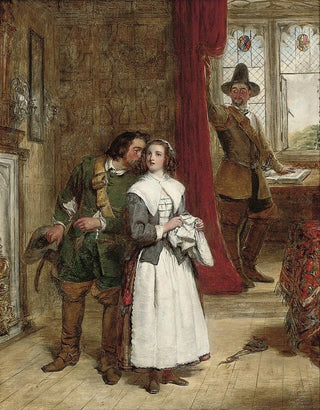Art print | The Puritans' Daughter - William Powell Frith


View from behind

Frame (optional)
In the captivating panorama of Victorian art, the art print "La fille des puritains" by William Powell Frith stands out for its narrative boldness and exploration of the social tensions of its time. This canvas, painted in 1851, immerses us in a scene that is both intimate and revealing, where the rigid conventions of puritanism clash with a young woman's quest for emancipation. Frith, a true chronicler of his era, uses his brush to capture not only human figures but also the subtleties of emotions and conflicts that inhabit them. Through this work, the viewer is invited to reflect on social norms and individual aspirations, making this painting a mirror of Victorian society.
Style and uniqueness of the work
Frith's style in "La fille des puritains" is characterized by striking realism, combined with meticulous attention to detail. Every element of the composition, from the expressions of the characters to the textures of the clothing, is treated with precision that confers emotional depth to the scene. The carefully orchestrated lighting highlights the faces and gestures, emphasizing the tensions between the protagonists. The color palette evokes an atmosphere that is both melancholic and hopeful, reinforcing the idea of a crucial choice to be made. Frith manages to visually translate the moral dilemmas of his time by placing a young woman with a determined expression at the heart of his painting, ready to defy the expectations of her environment. This ability to blend narration and aesthetics makes this work an emblematic example of the historical genre.
The artist and his influence
William Powell Frith, born in 1819, is often regarded as one of the most important painters of the Victorian period. His career, marked by a series of works capturing everyday life and customs of his time, testifies to his commitment to representing British society in all its complexity. Frith draws inspiration from his personal observations and contemporary events, allowing him to create paintings that resonate with the public of his era. His influence extends beyond his own production, inspiring many artists to explore social and psychological themes.

Matte finish

View from behind

Frame (optional)
In the captivating panorama of Victorian art, the art print "La fille des puritains" by William Powell Frith stands out for its narrative boldness and exploration of the social tensions of its time. This canvas, painted in 1851, immerses us in a scene that is both intimate and revealing, where the rigid conventions of puritanism clash with a young woman's quest for emancipation. Frith, a true chronicler of his era, uses his brush to capture not only human figures but also the subtleties of emotions and conflicts that inhabit them. Through this work, the viewer is invited to reflect on social norms and individual aspirations, making this painting a mirror of Victorian society.
Style and uniqueness of the work
Frith's style in "La fille des puritains" is characterized by striking realism, combined with meticulous attention to detail. Every element of the composition, from the expressions of the characters to the textures of the clothing, is treated with precision that confers emotional depth to the scene. The carefully orchestrated lighting highlights the faces and gestures, emphasizing the tensions between the protagonists. The color palette evokes an atmosphere that is both melancholic and hopeful, reinforcing the idea of a crucial choice to be made. Frith manages to visually translate the moral dilemmas of his time by placing a young woman with a determined expression at the heart of his painting, ready to defy the expectations of her environment. This ability to blend narration and aesthetics makes this work an emblematic example of the historical genre.
The artist and his influence
William Powell Frith, born in 1819, is often regarded as one of the most important painters of the Victorian period. His career, marked by a series of works capturing everyday life and customs of his time, testifies to his commitment to representing British society in all its complexity. Frith draws inspiration from his personal observations and contemporary events, allowing him to create paintings that resonate with the public of his era. His influence extends beyond his own production, inspiring many artists to explore social and psychological themes.






